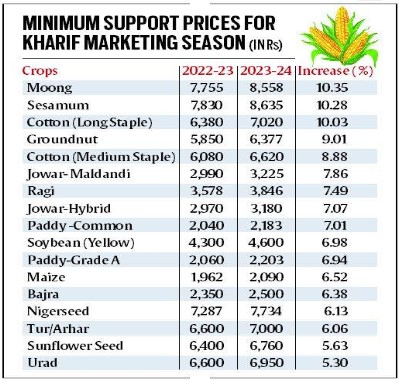- Courses
- GS Full Course 1 Year
- GS Full Course 2 Year
- GS Full Course 3 Year
- GS Full Course Till Selection
- Online Program
- GS Recorded Course
- NCERT (Recorded 500+ Hours)
- Polity Recorded Course
- Geography Recorded Course
- Economy Recorded Course
- AMAC Recorded Course
- Modern India, Post Independence & World History
- Environment Recoded Course
- Governance Recoded Course
- Science & Tech. Recoded Course
- International Relations and Internal Security Recorded Course
- Disaster Management Module Course
- Ethics Recoded Course
- Essay Recoded Course
- Current Affairs Recoded Course
- CSAT
- 5 LAYERED ARJUNA Mentorship
- Public Administration Optional
- ABOUT US
- OUR TOPPERS
- TEST SERIES
- FREE STUDY MATERIAL
- VIDEOS
- CONTACT US
Centre Sets Minimum Support Price for Kharif Crop
Centre Sets Minimum Support Price for Kharif Crop


Latest Context
To provide fair remuneration to farmers, the Central Government has approved the Minimum Support Price (MSP) for Kharif crops for the year 2023-24. But Farmer’s organizations are not satisfied with the MSP finalized by the government because of the sharp increase in the input cost.
Minimum Support Price
- Concept: It is a definite amount determined by the Government for the farmers when the government buys their farm produce. MSPs for twenty-two crops and fair and remunerative price (FRP) for sugarcane have been approved by the Government.
- There are 14 crops of the kharif season, 6 rabi crops, and two other commercial crops for which the Government mandated this MSP. Additionally, the MSPs of de-husked coconut and toria are determined on the basis of the MSPs of copra and rapeseed/mustard respectively.
- Commission for Agricultural Costs and Prices (CACP) determines the MSP by considering many factors like demand and supply, cost of production, inter-crop price parity, market price trends, etc.
- Commission for Agricultural Costs and Prices (CACP): The CACP which came into existence in 1965, is an attached office of the Ministry of Agriculture and Farmers Welfare, Government of India. The MSPs are approved by the Cabinet Committee on Economic Affairs (CCEA) headed by the Prime Minister of India. The objective of MSP is to provide remunerative prices to the farmers for their farm produce in addition to promoting the crop diversification.
Kharif Crops
- Kharif crops are the ones that are sowed in the rainy season, from June to September.
- Paddy, maize, millets, pulses, oilseeds, cotton and sugarcane are some examples of Kharif Crops.
- Approximately 55% of the total foodgrain production in India belongs to Kharif Crop.
MSP for Kharif Crops for 2023-24
- As per the Union Government, the increase in MSP for Kharif crops for 2023-24 matches with the recommendation made by the Union Budget 2018-19. It recommended that MSPs should be at least 1.5 times of the All-India weighted average cost of production.
- MSP has been increased for all 14 kharif crops ranging from 5.3 to 10.35 %. It has been increased by Rs 128 to Rs 805 per quintal in absolute terms.
- Green gram (moong) registered the highest increase of 10.4% over 2022-23 followed by sesamum with an increase of 10.3%.
Concerns of the Farmers
- Inadequate Prices: According to the Farmers, the cost determined by the CACP to calculate the MSP (A2+FL costs) is inaccurate because it does not comprise all the expenses incurred by the farmers like interest on loans, rent of land, family labour, etc. They urged the Central Government that MSP ought to be based on the comprehensive cost of production (C2) recommended by the Swaminathan Commission.
- Three Kinds of Production Cost
- ‘A2’: It is the expenditure incurred by the farmer to purchase seeds, fertilizers, pesticides, hired labour, leased-in land, fuel, irrigation, etc.
- ‘A2+FL’: It comprises A2 and an estimated value of unpaid family labour
- ‘C2’: It is a comprehensive cost that takes into consideration rent and interest foregone on land and machinery owned by farmers.
- Regional Disparities and Crop-Specific Issues: Farmers also pointed out that the regional disparities and crop-specific issues in the implementation of the MSP. According to them, some states and some crops get benefitted from the MSP while other crops and regions remain out of the coverage. According to the Farmers, MSP should be extended to all crops and all states, and there should be a legal guarantee for the MSP.
- Lack of Market Reflection: In addition, the present MSP does not take into account the actual market conditions and the inflationary trends. They urged that MSP ought to be connected to the Wholesale Price Index (WPI) or the Consumer Price Index (CPI) for securing fair returns for the farmers.
- Procurement Mechanism: Farmers raised very serious doubts over the availability of adequate infrastructure, procurement mechanism, and storage facilities to ensure that the farmers get the MSP for their produce. According to the farmers, the government takes the resort of import or export policies to manipulate the market prices and undermine the MSP.
Way Forward
- Diversification of Crops: Attention should be paid to crop diversification by promoting farmers to cultivate high-value and climate-resilient crops that can reduce their dependence on MSP for traditional crops. There is a dire need to bring about modern farming practices such as vertical farming, and organic farming so that farmers could tap into niche markets and earn higher profits.
- Technological Solutions:
- To implement advanced technologies such as IoT (Internet of Things), precision agriculture, and remote sensing that can help in optimizing crop yields, increasing farmers' access to information, and reducing production costs could be helpful in sorting out the issues of the farmers.
- It could be useful to develop mobile applications and platforms that provide weather updates, real-time market information, and best practices for farmers that make them capable to make informed decisions about crop selection and pricing.
- Public-Private Partnerships (PPPs):
- To promote constructive partnership between the government, private sector, and farmer organizations which could create market linkages, improve farmers' bargaining power, and enhance value addition.
- Joint initiatives like agri-logistics infrastructure development, contract farming, and agro-processing units to ensure a fair and remunerative market for farmers can give desired results.

Q. Consider the following statements: (2020)
1. In the case of all cereals, pulses, and oil seeds, the procurement at Minimum Support price (MSP) is unlimited in any State/UT of India.
2. In the case of cereals and pulses, the MSP is fixed in any State/UT at a level to which the market price will never rise.
Which of the statements given above is/are correct?
(a) 1 only
(b) 2 only
(c) Both 1 and 2
(d) Neither 1 nor 2
Ans: (d)
Q. Consider the following statements: (2023)
1. The Government of India provides Minimum Support Price for niger (Guizotia abyssinica) seeds.
2. Niger is cultivated as a Kharif crop.
3. Some tribal people in India use niger seed oil for cooking.
How many of the above statements are correct?
(a) Only one
(b) Only two
(c) All three
(d) None
Ans: (c)


